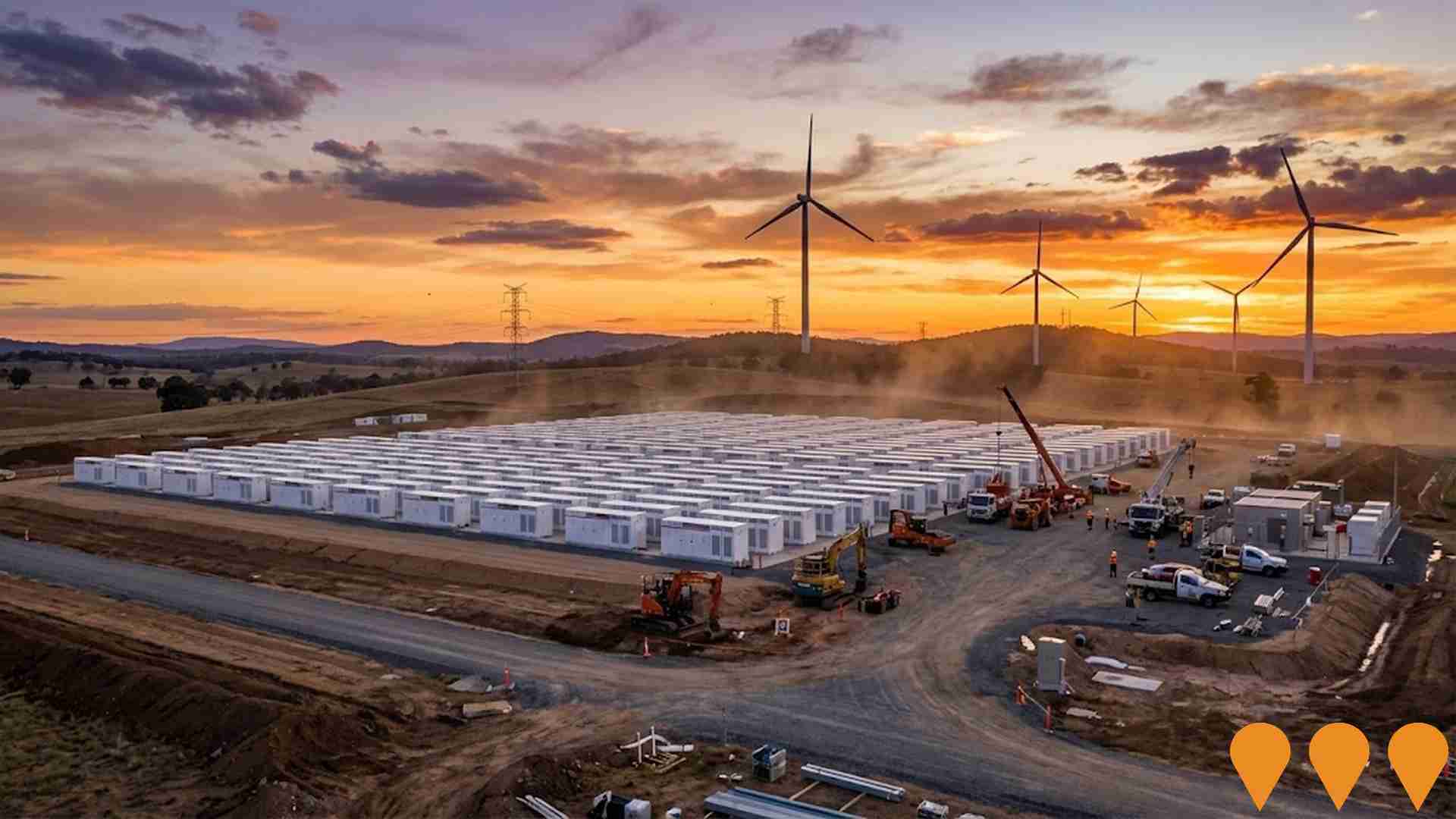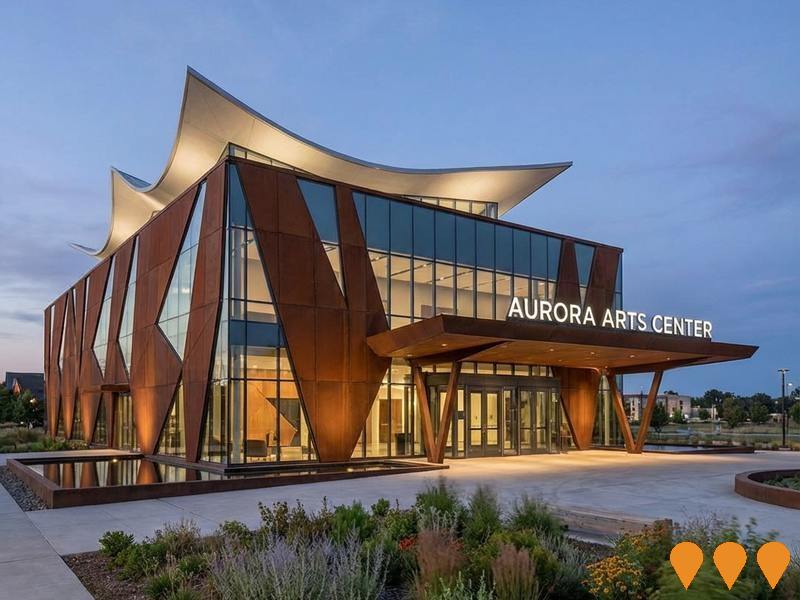Chart Color Schemes
est. as @ -- *
ABS ERP | -- people | --
2021 Census | -- people
Sales Activity
Curious about local property values? Filter the chart to assess the volume and appreciation (including resales) trends and regional comparisons, or scroll to the map below view this information at an individual property level.
Find a Recent Sale
Sales Detail
Population
An assessment of population growth drivers in Melba reveals an overall ranking slightly below national averages considering recent, and medium term trends
Melba's population was approximately 3,384 as of August 2025. This figure represents an increase of 1 person (0%) since the 2021 Census, which recorded a population of 3,383. The change is inferred from the estimated resident population of 3,382 in June 2024 and the addition of 6 validated new addresses since the Census date. This results in a population density ratio of 1,464 persons per square kilometer, higher than the average across national locations assessed by AreaSearch. Melba's 0% growth since the census places it within 2.4 percentage points of the SA3 area (2.4%), indicating competitive growth fundamentals. Overseas migration contributed approximately 64.7% of overall population gains during recent periods, driving primary population growth in the area.
AreaSearch uses ABS/Geoscience Australia projections for each SA2 area, released in 2024 with a base year of 2022. For areas not covered by this data and years post-2032, age group growth rates from the ACT Government's SA2 area projections are adopted, using 2022 as the base year. According to these projections, Melba's population is expected to decline by 311 persons by 2041. However, specific age cohorts are anticipated to grow, with the 85 and over age group projected to increase by 15 people.
Frequently Asked Questions - Population
Development
Residential development activity is lower than average in Melba according to AreaSearch's national comparison of local real estate markets
Melba averaged approximately 4 new dwelling approvals annually over the past five financial years, totalling 24 homes. As of FY-26, 0 approvals have been recorded so far. On average, each home built between FY-21 and FY-25 attracted about 5.1 new residents per year, indicating a significant gap between demand and supply that typically drives up prices and intensifies competition among buyers. The average construction cost of new homes in Melba was around $197,000 during this period, which is lower than regional levels, suggesting more affordable housing options for buyers.
This financial year has seen $626,000 in commercial development approvals, reflecting the area's residential nature. Compared to the Australian Capital Territory, Melba has notably less development activity, with 75.0% below the regional average per person. This limited new supply generally supports stronger demand and values for established homes, a trend also seen nationally due to the area's maturity and potential planning constraints. New building activity in Melba consists of approximately 67.0% detached houses and 33.0% medium and high-density housing, offering a mix of opportunities across different price brackets. With around 1087 people per approval, Melba is considered a mature, established area.
Population projections indicate stability or decline, suggesting reduced housing demand pressures in the future, which could benefit potential buyers.
Frequently Asked Questions - Development
Infrastructure
Melba has emerging levels of nearby infrastructure activity, ranking in the 25thth percentile nationally
The performance of an area can be significantly influenced by changes to local infrastructure, major projects, and planning initiatives. A total of one such project has been identified by AreaSearch as potentially impacting the area. Key projects include Ginninderry Stage 3 - The Valley Release, Ginninderry Estate - Stages 4-7 (Strathnairn & future Macnamara), Belconnen Lakeshore - Connected Waterfront Precinct, and New Northside Hospital.
Professional plan users can use the search below to filter and access additional projects.
INFRASTRUCTURE SEARCH
 Denotes AI-based impression for illustrative purposes only, not to be taken as definitive under any circumstances. Please follow links and conduct other investigations from the project's source for actual imagery. Developers and project owners wishing us to use original imagery please Contact Us and we will do so.
Denotes AI-based impression for illustrative purposes only, not to be taken as definitive under any circumstances. Please follow links and conduct other investigations from the project's source for actual imagery. Developers and project owners wishing us to use original imagery please Contact Us and we will do so.
Frequently Asked Questions - Infrastructure
Canberra Light Rail Stage 3: Belconnen to City (Bruce Alignment)
Planning and feasibility analysis for the future Stage 3 of the Canberra Light Rail network, connecting Belconnen Town Centre to the City via Bruce. The proposed corridor serves major precincts including the University of Canberra, CIT Bruce, North Canberra Hospital, and GIO Stadium. The project follows the Belconnen Transitway alignment and aims to provide high-capacity public transport to the north-west.

New Northside Hospital (North Canberra Hospital Redevelopment)
Development of a new major tertiary hospital on the existing North Canberra Hospital campus (formerly Calvary Public Hospital). The project involves an investment of over $1 billion to construct a new state-of-the-art clinical services building, expanded emergency department, and modern inpatient facilities to replace aging infrastructure.
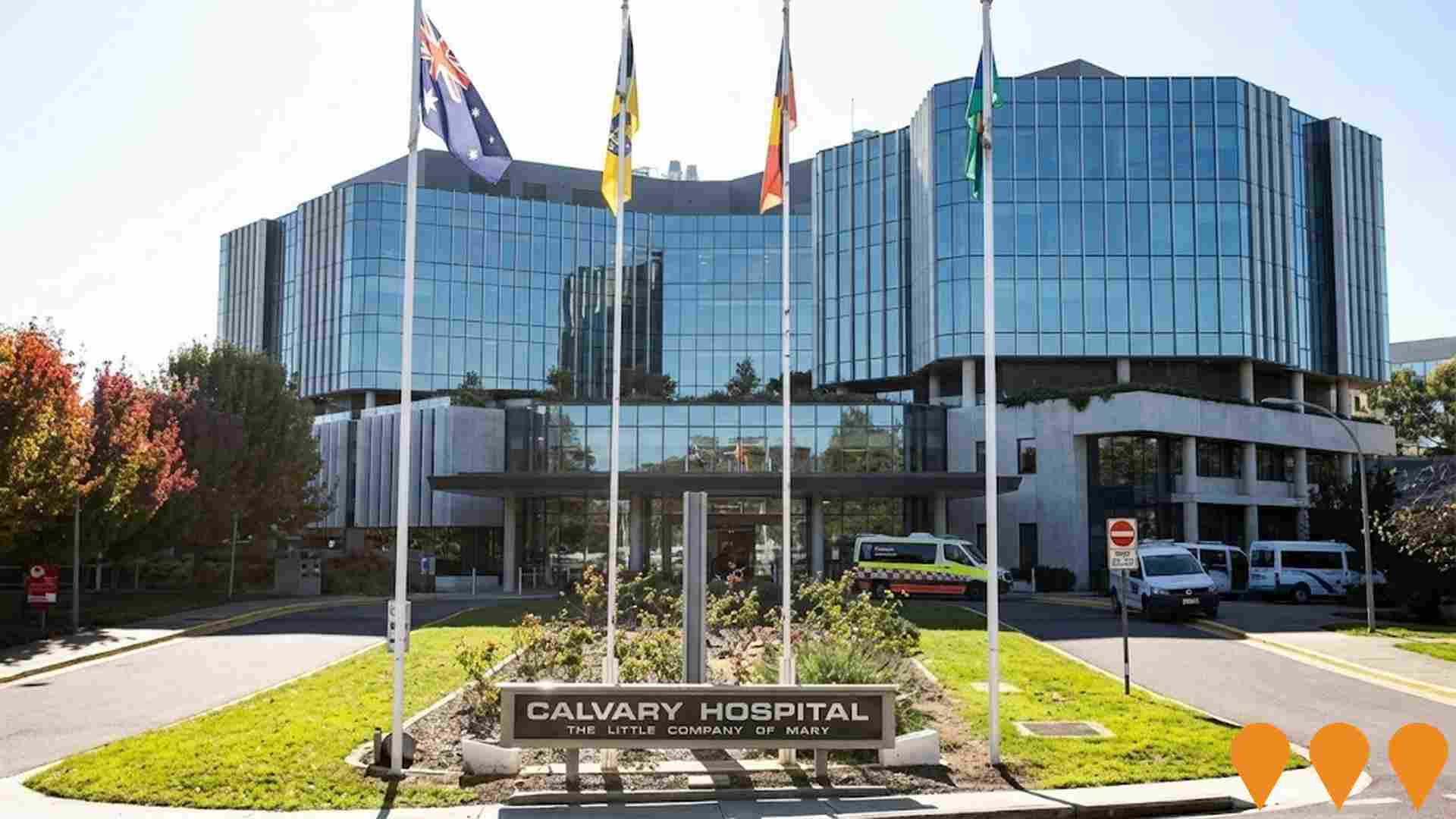
Low and Mid-Rise Housing Policy
State-wide NSW planning reforms via amendments to the State Environmental Planning Policy to enable more diverse low and mid-rise housing (dual occupancies, terraces, townhouses, manor houses and residential flat buildings up to 6 storeys) in well-located areas within 800 m of selected train, metro and light-rail stations and town centres. Stage 1 (dual occupancies in R2 zones statewide) commenced 1 July 2024. Stage 2 (mid-rise apartments, terraces and dual occupancies near stations) commenced 28 February 2025. Expected to facilitate up to 112,000 additional homes over the next five years.
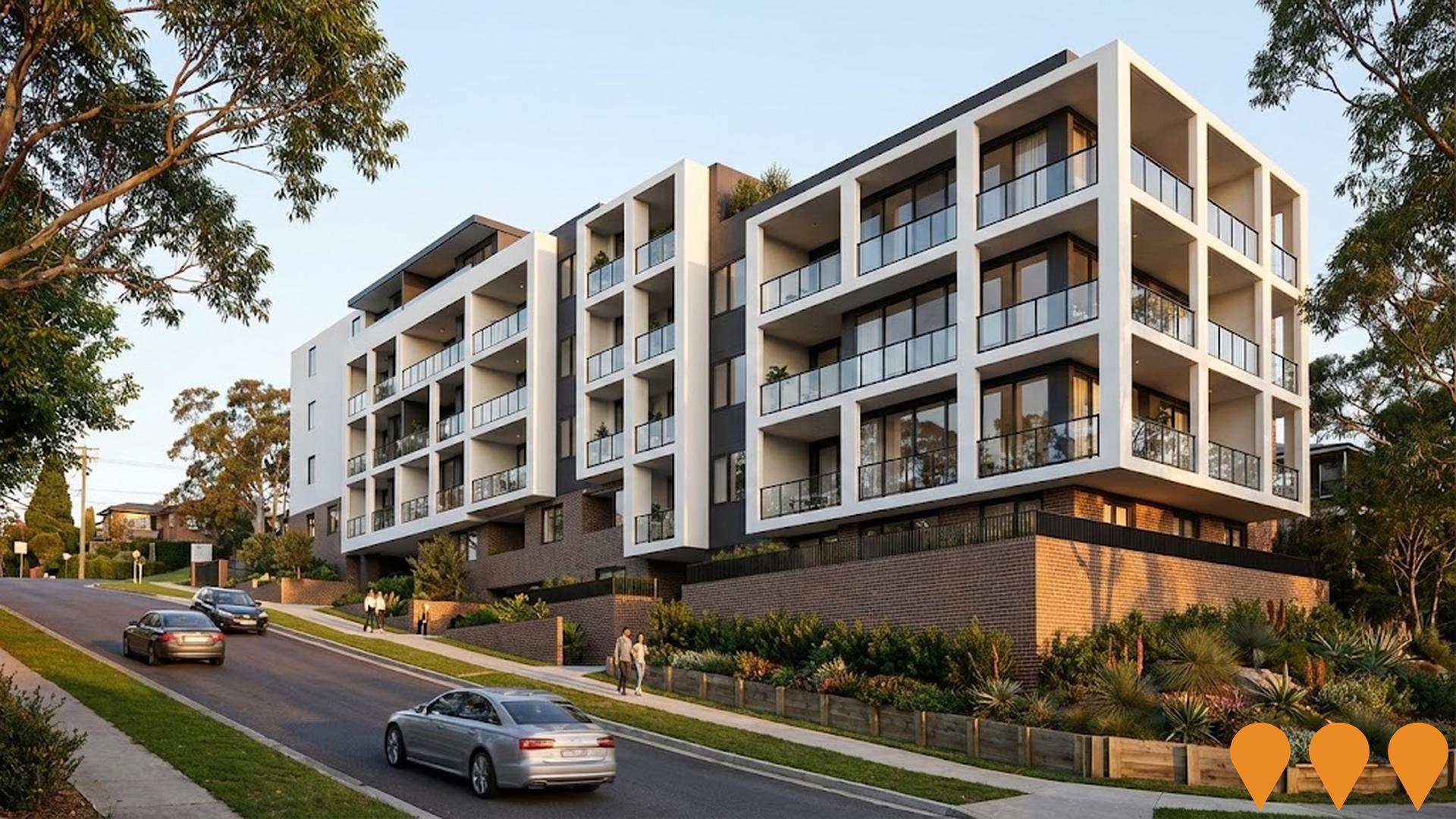
Ginninderry Estate - Stages 4-7 (Strathnairn & future Macnamara)
Canberra's largest master-planned community spanning the ACT-NSW border, delivering approximately 11,500 dwellings total, with ongoing stages immediately adjacent to and west of Dunlop.
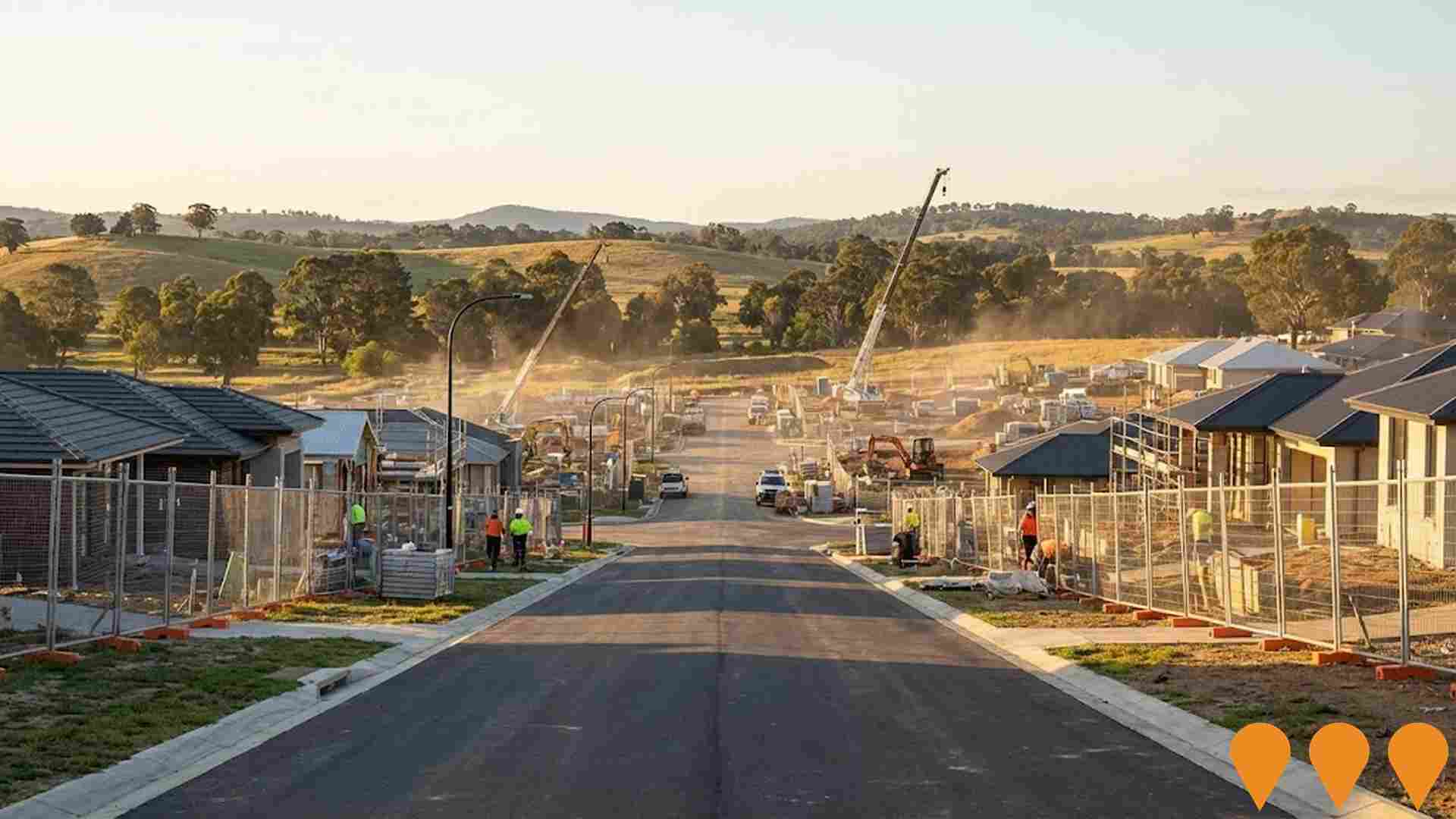
Belconnen Lakeshore - Connected Waterfront Precinct
Belconnen Lakeshore is an ACT Government land release and urban renewal project on the Lake Ginninderra foreshore at Emu Inlet. Guided by the Belconnen Town Centre Place Design Brief, the project will transform four waterfront sites including the Circus Sites Precinct and the former Water Police site into a mixed use precinct with new public waterfront promenades, upgraded open space and taller mixed use buildings stepping up from the lake edge. The Suburban Land Agency has run a two stage tender process for the land release and evaluated tenders, but as at mid 2025 the lakeshore blocks have not yet been sold, with final sale and detailed development design still to be confirmed.

Enhanced bus and light rail corridors (Belconnen & Queanbeyan to Central Canberra)
ACT is progressing an integrated program to enhance high-frequency bus and future light rail corridors that link Belconnen and Queanbeyan with central Canberra. Light Rail Stage 2A (City to Commonwealth Park) commenced construction in early 2025 with services targeted from 2028, while planning and approvals continue for Stage 2B to Woden. The ACT Government has acknowledged and is planning upgrades for the Belconnen-to-City bus corridor as groundwork for a future east-west light rail Stage 3, and is coordinating cross-border public transport initiatives with NSW through the Queanbeyan Region Integrated Transport Plan and the ACT-NSW MoU for Regional Collaboration.
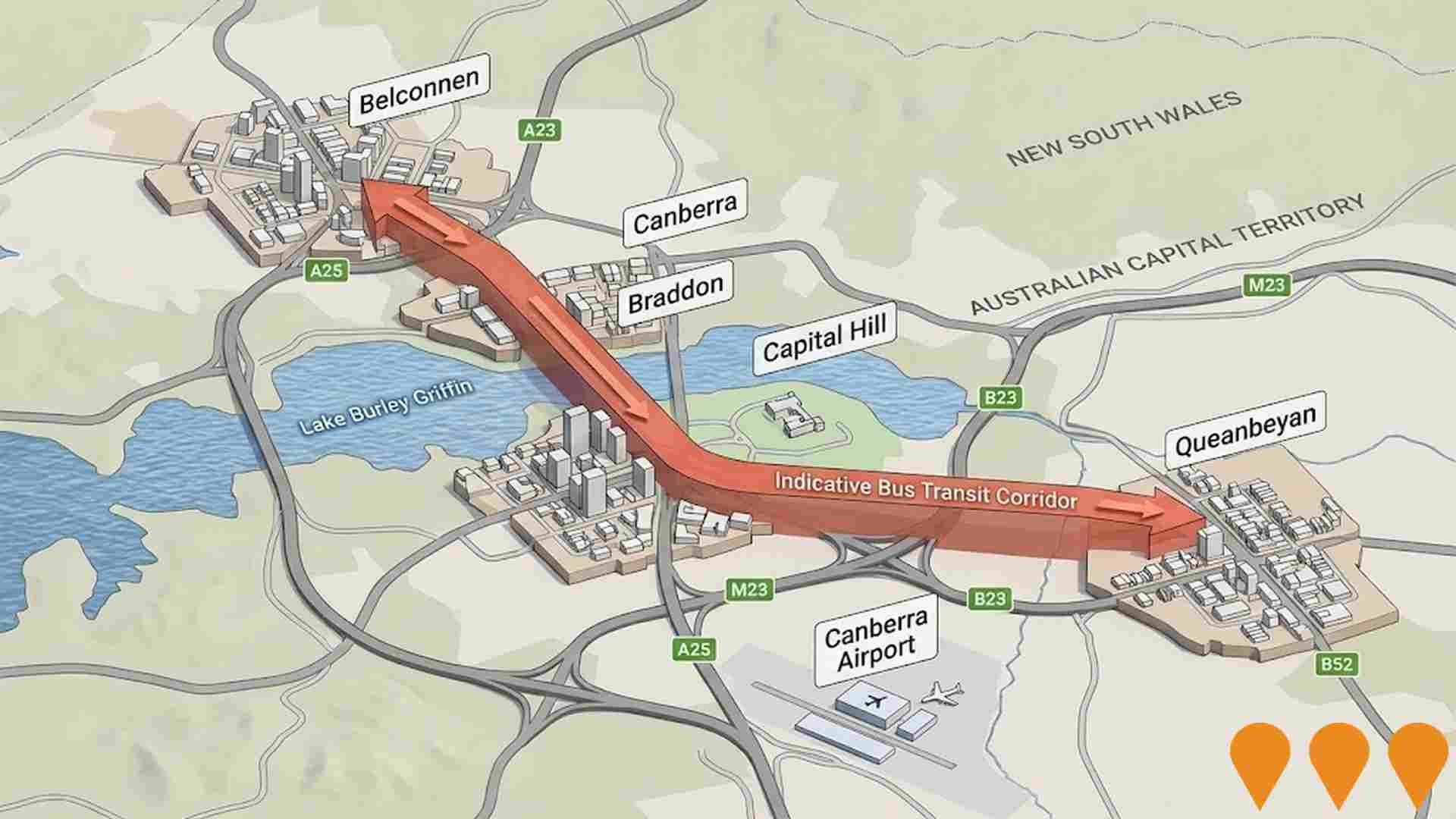
HumeLink
HumeLink is a new 500kV transmission line project connecting Wagga Wagga, Bannaby, and Maragle, spanning approximately 365 km. It includes new or upgraded infrastructure at four locations and aims to enhance the reliability and sustainability of the national electricity grid by increasing the integration of renewable energy sources such as wind and solar.
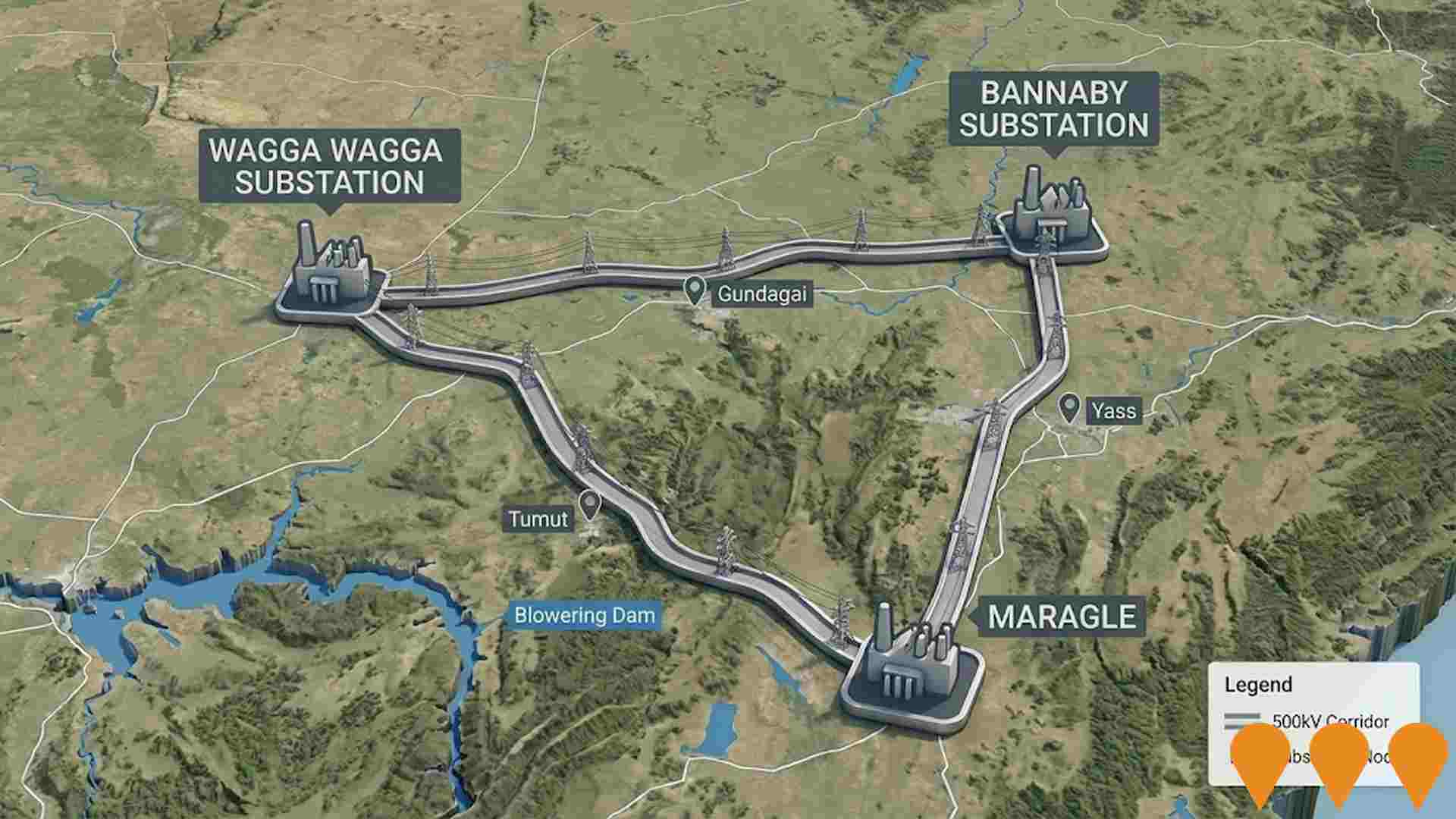
Queanbeyan Regional Integrated Transport Plan
Comprehensive transport planning initiative with 64 key actions for next 10 years. Addresses road safety, active transport connectivity, public transport availability, and future transport needs. Improved connections between Queanbeyan and ACT.
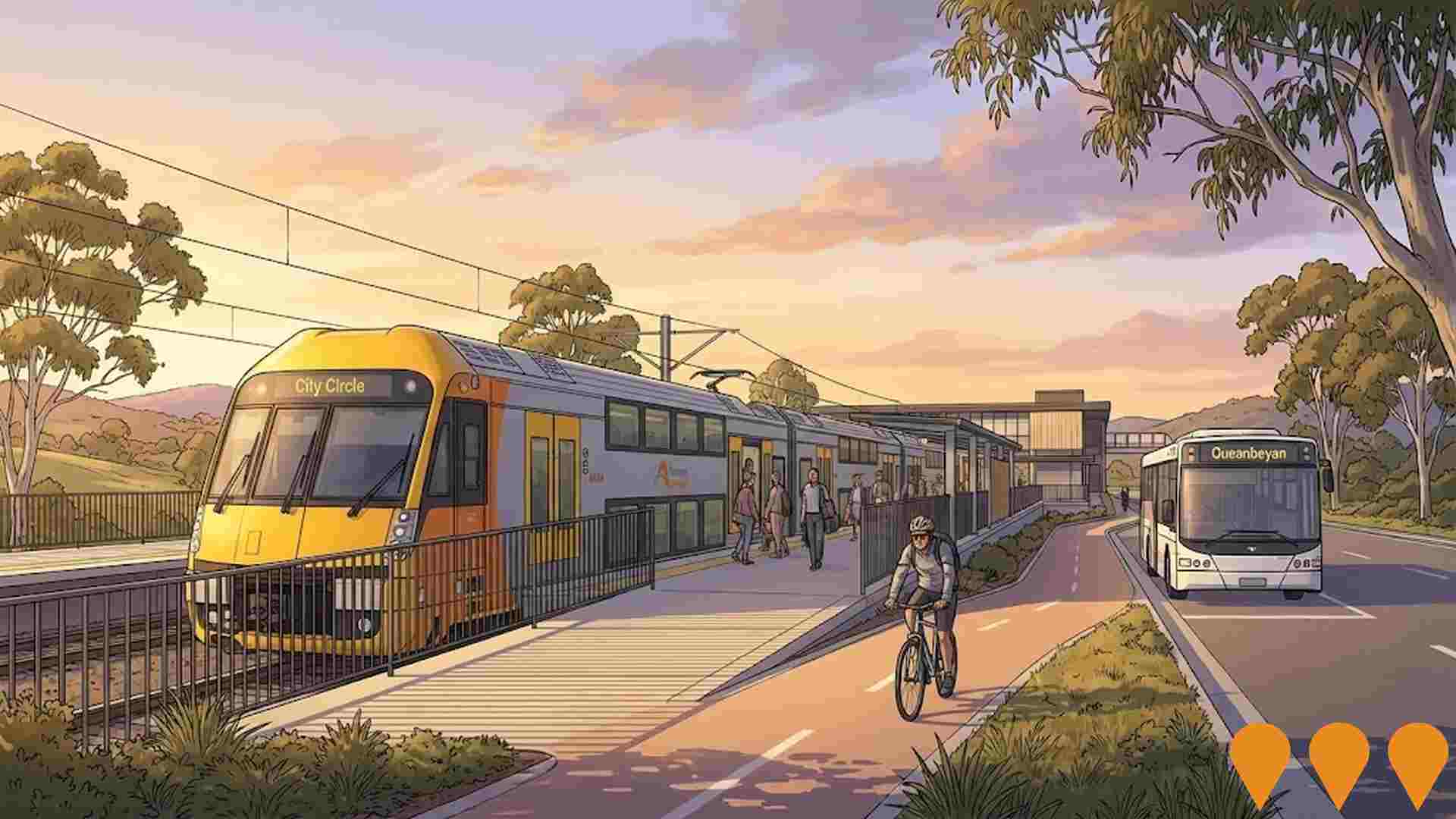
Employment
AreaSearch analysis reveals Melba recording weaker employment conditions than most comparable areas nationwide
Melba has a highly educated workforce with strong representation in professional services. The unemployment rate was 5.2% as of June 2025.
Employment growth over the past year was estimated at 1.8%. There were 1,715 residents employed while the unemployment rate was 1.8% higher than the Australian Capital Territory's rate of 3.4%. Workforce participation was lower at 65.0%, compared to the ACT's 69.6%. Leading employment industries among residents include public administration & safety, education & training, and professional & technical services.
The area has a particular specialization in education & training, with an employment share of 1.3 times the regional level. However, public administration & safety employs just 25.9% of local workers, below the ACT's 30.4%. The predominantly residential area appears to offer limited employment opportunities locally, as indicated by the count of Census working population vs resident population. Between June 2024 and June 2025, employment increased by 1.8% alongside labour force increasing by 1.6%, causing the unemployment rate to fall by 0.3 percentage points. In comparison, the ACT recorded employment growth of 1.9%, labour force growth of 1.6%, with unemployment falling by 0.3 percentage points. Jobs and Skills Australia's national employment forecasts from May 2025 suggest that national employment is forecast to expand by 6.6% over five years and 13.7% over ten years, but growth rates differ significantly between industry sectors. Applying these projections to Melba's employment mix suggests local growth of approximately 6.5% over five years and 13.2% over ten years.
Frequently Asked Questions - Employment
Income
The economic profile demonstrates exceptional strength, placing the area among the top 10% nationally based on comprehensive AreaSearch income analysis
Melba has a median taxpayer income of $65,611 and an average income of $74,164 based on postcode level ATO data aggregated by AreaSearch for the financial year 2022. This is higher than national averages, with ACT's median income being $68,678 and average income $83,634. By September 2025, estimates suggest Melba's median income will be approximately $74,534 and average income $84,250, considering a 13.6% Wage Price Index growth since 2022. According to the 2021 Census, incomes in Melba rank highly nationally, between the 85th and 87th percentiles for households, families, and individuals. Incomes of $1,500 - 2,999 account for 31.0% of residents (1,049 individuals), similar to the regional average of 34.3%. High weekly earnings exceeding $3,000 are achieved by 38.1% of households, indicating robust consumer spending. After housing costs, residents retain 87.3% of their income, reflecting strong purchasing power. Melba's SEIFA income ranking places it in the 8th decile.
Frequently Asked Questions - Income
Housing
Melba is characterized by a predominantly suburban housing profile, with above-average rates of outright home ownership
In Melba, as per the latest Census, 80.8% of dwellings were houses, with the remaining 19.2% comprising semi-detached homes, apartments, and other types. This compares to the Australian Capital Territory's figures of 69.4% houses and 30.5% other dwellings. Home ownership in Melba stood at 35.5%, with mortgaged properties making up 43.8% and rented dwellings accounting for 20.6%. The median monthly mortgage repayment was $2,100, higher than the Australian Capital Territory average of $2,000. The median weekly rent in Melba was $400, compared to the Australian Capital Territory's $430. Nationally, Melba's mortgage repayments exceeded the Australian average of $1,863, while rents were higher than the national figure of $375.
Frequently Asked Questions - Housing
Household Composition
Melba has a typical household mix, with a higher-than-average median household size
Family households account for 76.5 percent of all households, including 36.9 percent couples with children, 27.6 percent couples without children, and 11.1 percent single parent families. Non-family households constitute the remaining 23.5 percent, with lone person households at 21.0 percent and group households comprising 2.7 percent of the total. The median household size is 2.7 people, which is larger than the Australian Capital Territory average of 2.5.
Frequently Asked Questions - Households
Local Schools & Education
Melba shows strong educational performance, ranking in the upper quartile nationally when assessed across multiple qualification and achievement indicators
The area's educational profile exceeds the Australian average in university qualification rates, with 40.3% of residents aged 15+ having such qualifications compared to the national average of 30.4%. Bachelor degrees are most common at 23.9%, followed by postgraduate qualifications (11.9%) and graduate diplomas (4.5%). Vocational credentials are also prevalent, with 29.5% of residents aged 15+ holding such qualifications – advanced diplomas at 11.4% and certificates at 18.1%.
Educational participation is high, with 31.7% of residents currently enrolled in formal education. This includes 12.0% in primary education, 7.5% in secondary education, and 5.8% pursuing tertiary education. Melba's 3 schools have a combined enrollment of 1,342 students, with typical Australian school conditions (ICSEA: 1040) offering balanced educational opportunities. Educational provision is split between 1 primary and 2 secondary institutions. The area functions as an education hub, with 39.7 school places per 100 residents – significantly above the regional average of 15.1 – attracting students from surrounding communities.
Frequently Asked Questions - Education
Schools Detail
Nearby Services & Amenities
Transport
Transport servicing is high compared to other areas nationally based on assessment of service frequency, route connectivity and accessibility
Melba has 43 operational public transport stops, all of which serve buses. These stops are covered by 12 different routes, offering a total of 1,085 weekly passenger trips. The transport accessibility is rated excellent, with residents usually being 157 meters away from the nearest stop.
On average, there are 155 trips per day across all routes, which translates to approximately 25 weekly trips per individual stop.
Frequently Asked Questions - Transport
Transport Stops Detail
Health
Health performance in Melba is lower than average with common health conditions somewhat prevalent across both younger and older age cohorts
Melba faces significant health challenges with common health conditions somewhat prevalent across both younger and older age cohorts.
The rate of private health cover is very high at approximately 56%, covering about 1,911 people in total. Mental health issues impact 10.1% of residents, while asthma affects 9.6%. A total of 65.9% declare themselves completely clear of medical ailments, compared to 68.1% across the Australian Capital Territory. The area has 16.8% of residents aged 65 and over (567 people), which is higher than the 15.3% in the Australian Capital Territory. Health outcomes among seniors are above average, performing even better than the general population in health metrics.
Frequently Asked Questions - Health
Cultural Diversity
The level of cultural diversity witnessed in Melba was found to be above average when compared nationally for a number of language and cultural background related metrics
Melba's population showed cultural diversity with 21.9% born overseas and 16.5% speaking a language other than English at home. Christianity was the predominant religion, accounting for 45.4%. The 'Other' religious category was slightly overrepresented in Melba at 1.2%, compared to the Australian Capital Territory's 1.3%.
Ancestry-wise, Australians made up 27.2% of Melba's population, followed by English at 24.9% and Irish at 9.2%. Notable differences were observed in Welsh (0.7% vs regional 0.6%), Croatian (0.8% vs 0.8%), and Serbian (0.4% vs 0.3%) ethnic groups.
Frequently Asked Questions - Diversity
Age
Melba's population is slightly younger than the national pattern
Melba's median age is 38 years, which is higher than the Australian Capital Territory average of 35 but equivalent to the Australian median of 38. Compared to the Australian Capital Territory, Melba has a higher percentage of residents aged 5-14 (15.2%) but fewer residents aged 25-34 (11.7%). Between the 2021 Census and now, the population aged 15 to 24 has increased from 11.0% to 12.8%, while the 0 to 4 age group has decreased from 7.1% to 5.9%. The 45 to 54 age group has also declined, from 13.5% to 12.4%. By 2041, demographic modeling suggests Melba's age profile will change significantly. The 45 to 54 cohort is projected to grow by 4%, adding 18 residents to reach a total of 439. Conversely, both the 15 to 24 and 0 to 4 age groups are expected to decrease in number.
